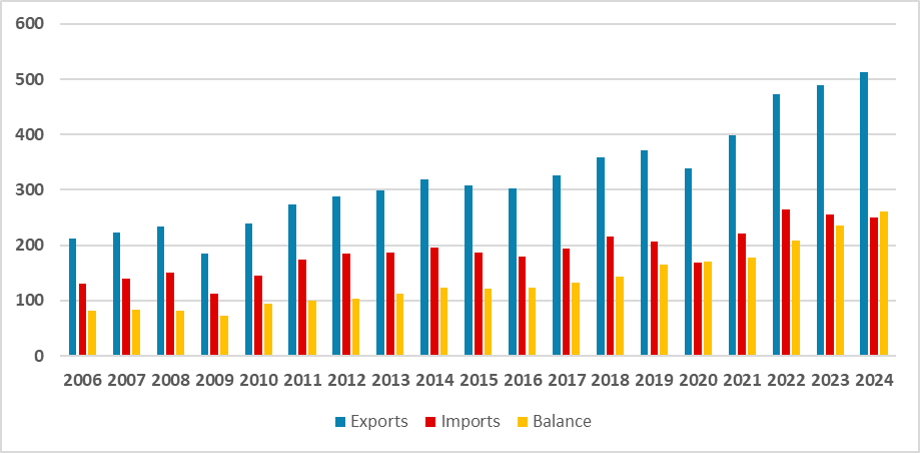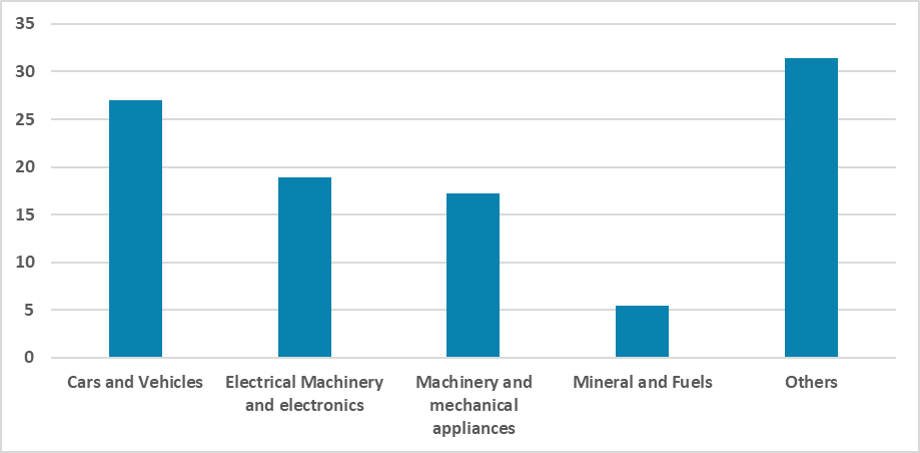Mexico: Uncertainty Mounts as Tariffs Are Imposed
Trump's administration has moved forward with 25% tariffs on Mexican imports, citing drug trafficking and migration issues. Mexico’s President Sheinbaum has stated retaliatory measures will be announced on March 9. The tariffs could push Mexico into recession in 2025, although we forecast growth at 0.8% only incorporating the uncertainty effects from tariffs. U.S.-Mexico trade links are deeply integrated but Mexico is more vulnerable. Retaliatory measures will likely target U.S. trade surpluses, but ongoing uncertainty may hinder foreign investment and affect economic growth. Inflationary pressures from exchange rate depreciation are expected to be minor.
Figure 1: Mexico’s Trade Balance With U.S. (USD Bln)

Source: Banxico
Trump’s administration decided to go forward with the proposed 25% tariffs on imports arriving from Mexico. Most of Trump's requests from Mexico were related to issues concerning drug trafficking and migration. Whether he sought Mexico's action on these issues or simply used them as an excuse to impose tariffs is yet unknown. Mexico’s President Claudia Sheinbaum stated that Mexico would seek retaliatory measures, and multiple plans had already been designed to respond. However, these measures will only be announced on March 9, which gives both sides some time to talk.
Figure 2: Share of Exports to the U.S. in 2023 (%)

Source: OEC
The maintenance of the tariffs could lead Mexico to face a recession in 2025. Less demand from the U.S., coupled with the lagged effects of tight monetary policy, will make growth more difficult this year. However, the continuation of the tariffs is still very uncertain, and our baseline forecast, which only incorporates the current uncertainty of the tariffs, points to growth of around 0.8% in 2025. Although the tariffs hurt the U.S. economy, which has highly integrated value chains with Mexico, especially in the vehicles and machinery sectors, they have the most potential to harm the Mexican economy. As we stated (here), Mexico’s plan focuses on further integration with North America, and if Trump frustrates this plan, new strategies will be needed, and more integration with China may be sought.
Around 40% of Mexican GDP depends on the U.S., with manufacturing being the most linked sector. Approximately 85% of Mexico’s exports are directed to the U.S., meaning tariffs could be a significant blow to the Mexican economy. Possible retaliatory measures are likely to be carefully designed to avoid major harm to Mexico’s economy. According to local media reports, Mexico will likely impose tariffs on products for which the U.S. has a trade surplus with Mexico, and Mexico will also try to reduce oil imports from the U.S. by seeking to increase its refinery capacity.
We still have doubts about whether the 25% tariffs will last. Clearly, Mexico’s authorities will aim to find some form of cooperation and avoid the imposition of tariffs. The March 9 date for Mexico’s retaliatory measures also suggests a desire to further negotiate with the U.S. and avoid tariffs. The uncertainty surrounding this situation will likely prevent further investment from foreign companies seeking to benefit from nearshoring, and tensions will likely persist during Trump’s administration, which we see primarily affecting growth. Inflationary pressures could arise from the exchange rate depreciation, but at this moment, we believe its impact will be minor.